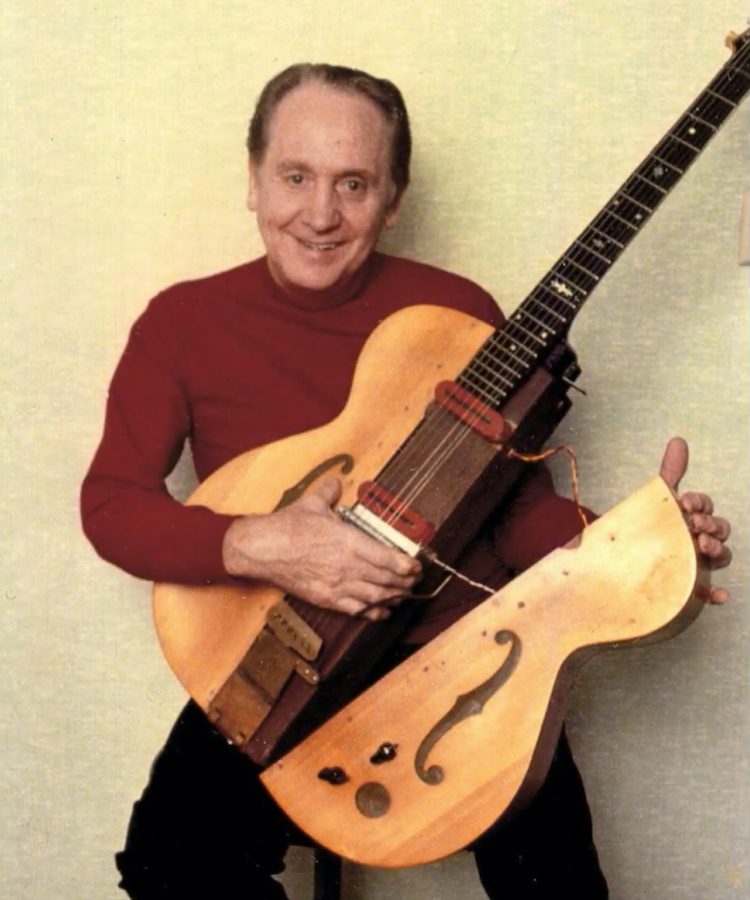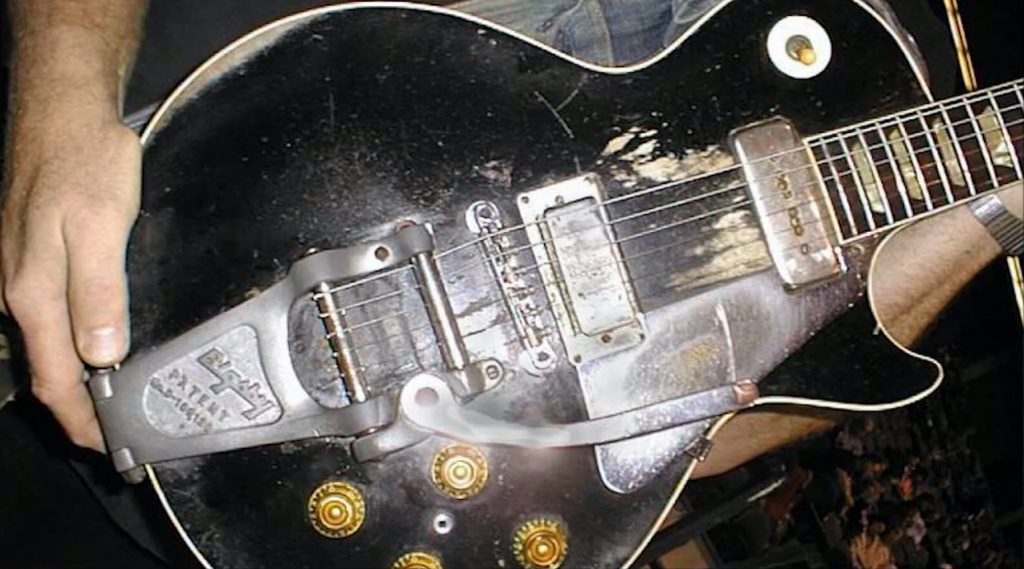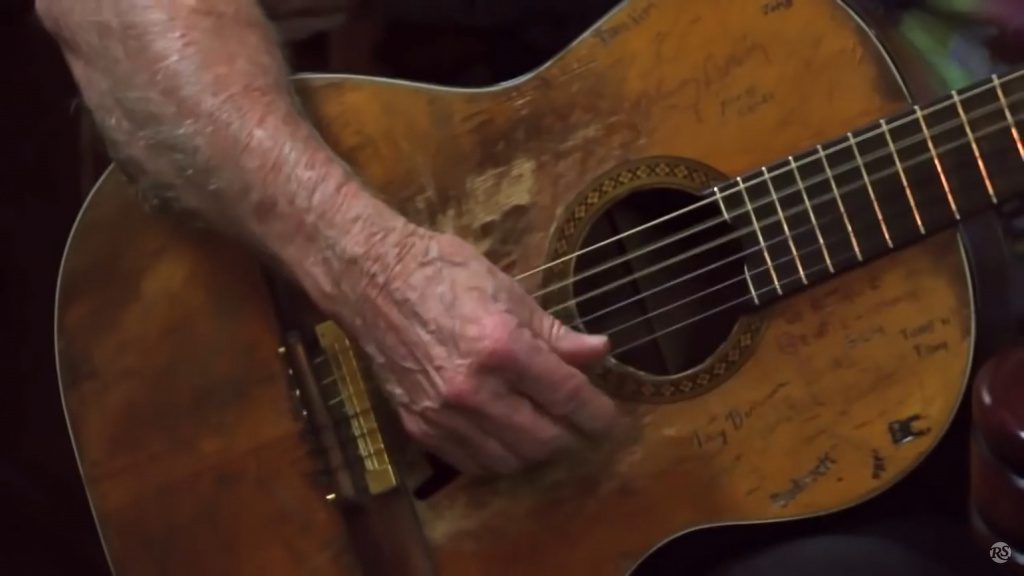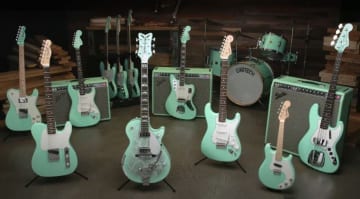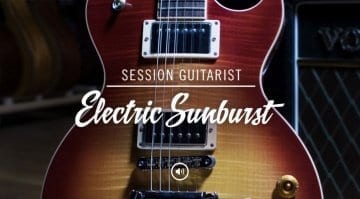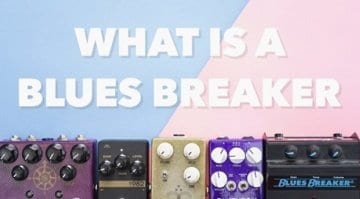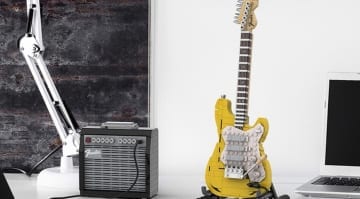Five legendary guitarists and their iconic instruments
JJ Cale, Les Paul, Neil Young, Willie Nelson and Peter Green and the unique instruments that moulded their sound
Modifications, cosmetic or otherwise, are a relatively easy way to make guitars unique and distinct. Sometimes, the modifications come out of necessity, sometimes they’re there just to add a personal flavour. Sometimes the instruments are expensive, and sometimes very cheap. Even something as insignificant as the right sticker at the right place, gives the guitar an instant identity.
There are so many guitars that are almost as famous as their owners. Eddie Van Halen’s Frankenstrat is not only identifiable for its unique artwork, but also EVH’s inventive wiring system. Sometimes stickers, like Stevie Ray Vaughan’s “SRV” on his Fender Stratocasters, or the “Blue Dress” On Jerry Cantrell’s G&L Rampage, make them recognisable. A mod, like the “Monkey Grip” on Steve Vai’s Ibanez JEM models, or Malcolm Young taking the pickups out of his Gretsch G6131, makes it unique. Other times, guys like Brian May, with his Red Special, make their own guitar, and proceed to take over the world with it. It would take forever compiling a list of guitars that have become synonymous with their players, but here are a few interesting examples.
Les Paul’s The Log
The Gibson Les Paul model, especially the “Bursts” from 1958-1960, are considered by many the most desirable electric guitars. Some people are willing to pay lots of money for them. It’s a timeless design and most guitar players, and even non-players, are aware of its now classic shape. So when I actually saw Les Paul’s original “Log” guitar – a crucial step in the development of the Les Paul – for the first time, I was a bit stunned.
I had read about it, but it was hard to imagine what it quite looked like. But nothing like the Log existed then, and the guitar proved to be years ahead of its time. Les Paul, a bonafide genius, was trying to get a guitar that would sustain longer and didn’t feedback like a traditional hollow-body guitar. This resulted in him making a guitar out of a 4×4 slab of pine and an Epiphone Broadway neck, with homemade parts and electronics.
Even in today’s modern guitar world, where so many shapes and designs abound, it would be sure to turn heads. So it’s no surprise, that Les’s audiences didn’t have the most positive reaction to this outlandish looking instrument. Les took note and added “wings” to his Log, from a sawed off Epiphone, to make it look more conventional. “People listen with their eyes,” Les concluded. I mean, look at it:
Broomstick with pickups
Les took his invention to Epiphone, who turned it down, and then Gibson, who called it “a broomstick with pickups”. But we all know the story doesn’t end there. He was called back by Gibson in 1951 and the rest, as they say, is history. I wonder how many would be interested in a reissue of the Log, and how much they’d be willing to pay for a vintage correct one!
JJ Cale’s Harmony H162
I’m a huge JJ Cale fan. With so many blistering guitar players everywhere, I found his relaxed style refreshing. Everything about his sound is laid back: the songs, the voice, and the guitar. I was always interested to know what guitar he played. And I finally saw it while watching a recording of a concert of him and his band with Leon Russell at Russell’s Paradise Studios. And fascinating it was.
What started life as a Harmony H162 acoustic guitar, an inexpensive model to begin with, was modified beyond recognition. The original got damaged during a flight, so Cale reconstructed it with a cutaway, an assortment of pickups, and a whole array of controls and switches. It’s even got a big red light. In the clip below, he shows a hole he fashioned on the side of the guitar with a hammer, so that he could attach a microphone to it. A practical guy. The guitar had to be eventually retired.
You are currently viewing a placeholder content from YouTube. To access the actual content, click the button below. Please note that doing so will share data with third-party providers.
Peter Green’s 1959 Gibson Les Paul
Much has already been written about Peter Green’s tone. Many guitarists, and manufacturers, modify their instruments to get that legendary “out-of-phase” Peter Green sound. But before it was finally unearthed, many people thought the secret to Green’s tone was the flipped neck pickup in his Les Paul.
Peter Green himself was inspired by Eric Clapton to hunt down a 1959 Gibson Les Paul. After seeing Clapton one night use only the bridge pickup of his Les Paul, Green decided he didn’t need the neck pickup either and took it out of his guitar. When he eventually put it back in, he put it the wrong way around. And the myth of how he got his distinct tone was born.
Of course, now we know that it was the magnets that were ‘out of phase’, and that Green’s Les Paul wasn’t the only one with such PAFs. Although, it’s probably the most famous one. And this tiny detail has made the Greeny Les Paul instantly recognisable, at least to me. A quick look at the neck pickup and you know if it is Peter Green’s Les Paul, or one inspired by it. The guitar was later owned by Gary Moore, and now, more recently, by Kirk Hammett of Metallica. Here’s a clip of Greeny, un-altered:
You are currently viewing a placeholder content from YouTube. To access the actual content, click the button below. Please note that doing so will share data with third-party providers.
Neil Young’s Old Black
Old Black is Neil Young’s early ’50s heavily modified Les Paul Goldtop, that has accompanied him on his eclectic and varied journey. Young’s playing style is erratic and unpredictable, and might not be everyone’s cup of tea. To me, that makes it exciting and urgent. He’s considered by many to be the Godfather of Grunge, and Old Black and its tone definitely gets some credit there. Chris Cornell had a tribute model in his arsenal, which can be seen in the Soundgarden Premier Guitar Rig Rundown video (around 46:31).
It’s had several modifications to it over the course of its illustrious career. Painted black, had Bigsby’s installed, pickups swapped out, bridge replaced, tuners replaced. Also, the neck was replaced at some point before it got painted. So it’s a long ways away from where it started life, and while most people would be shocked to see this level of modification on a Les Paul, especially on a vintage one, Old Black gets a pass. And by all accounts, the guitar is falling apart, but Young refuses to retire it. Old Black was one of the guitars used in his Dead Man soundtrack, and the guitar tone is thunderous! According to Pitchfork, “Old Black is featured in its purest form” here. Hear the glorious, drenched in delay and reverb, tone below:
You are currently viewing a placeholder content from YouTube. To access the actual content, click the button below. Please note that doing so will share data with third-party providers.
Willie Nelson’s Trigger
Sometimes, a seemingly un-modified instrument becomes easily identifiable just by wear, like Rory Gallagher’s severely worn-out Fender Stratocaster. Willie Nelson’s Martin N-20, affectionately named Trigger, would also fall under this category. Nelson acquired the guitar to replace the one he was using, after a drunk man stepped on it. Since then, he has worn through the top of the guitar, between the soundhole and the bridge, and had over a hundred people sign it. I like seeing Trigger. I like it when a guitar has been loved to the point of falling apart. There’s something charming about that. And I have very rarely, if ever, seen the extent of wear that Trigger has, on any other acoustic. In the late ‘90s, Martin issued the Willie Nelson Limited Edition N-20WN, based on Trigger. Sadly, it did not feature the wear, or the signatures.
There are so many other famous guitars. David Gilmour’s Black Strat, Bo Diddly’s square Gretsch, Prince’s custom-made cloud guitars, or Jerry Garcia’s Doug Irwin models. Ultimately, most of these players have also proven that their tones are instantly apparent, regardless of their choice of instrument.
What are some of your favourite iconic guitars? Let us know in the comments section below!
The TRUTH about Les Paul’s First Guitar
You are currently viewing a placeholder content from YouTube. To access the actual content, click the button below. Please note that doing so will share data with third-party providers.
JJ Cale – After Midnight
You are currently viewing a placeholder content from YouTube. To access the actual content, click the button below. Please note that doing so will share data with third-party providers.
Neil Young with Old Black in 1978
You are currently viewing a placeholder content from YouTube. To access the actual content, click the button below. Please note that doing so will share data with third-party providers.
Rig Rundown – Soundgarden
You are currently viewing a placeholder content from YouTube. To access the actual content, click the button below. Please note that doing so will share data with third-party providers.
Willie Nelson and His Famous Guitar: The Tale of Trigger
You are currently viewing a placeholder content from YouTube. To access the actual content, click the button below. Please note that doing so will share data with third-party providers.
 5,0 / 5,0 |
5,0 / 5,0 | 